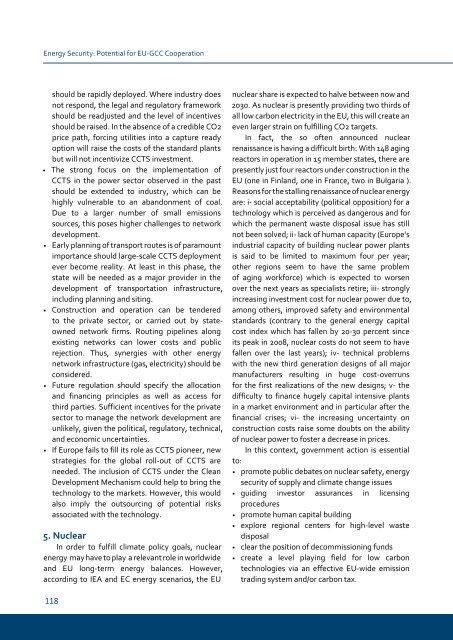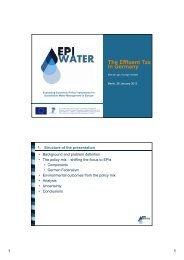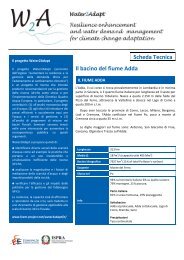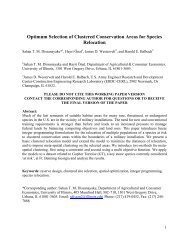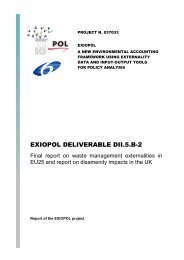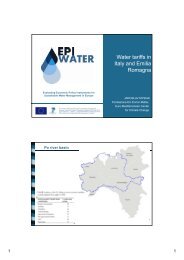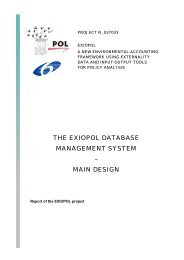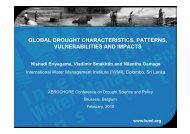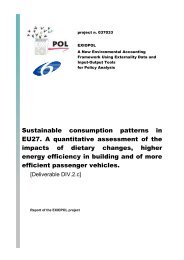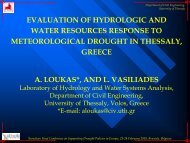Gulf and European Energy Supply Security - Feem-project.net
Gulf and European Energy Supply Security - Feem-project.net
Gulf and European Energy Supply Security - Feem-project.net
Create successful ePaper yourself
Turn your PDF publications into a flip-book with our unique Google optimized e-Paper software.
<strong>Energy</strong> <strong>Security</strong>: Potential for EU-GCC Cooperation<br />
•<br />
•<br />
•<br />
•<br />
•<br />
11<br />
should be rapidly deployed. Where industry does<br />
not respond, the legal <strong>and</strong> regulatory framework<br />
should be readjusted <strong>and</strong> the level of incentives<br />
should be raised. In the absence of a credible CO2<br />
price path, forcing utilities into a capture ready<br />
option will raise the costs of the st<strong>and</strong>ard plants<br />
but will not incentivize CCTS investment.<br />
The strong focus on the implementation of<br />
CCTS in the power sector observed in the past<br />
should be extended to industry, which can be<br />
highly vulnerable to an ab<strong>and</strong>onment of coal.<br />
Due to a larger number of small emissions<br />
sources, this poses higher challenges to <strong>net</strong>work<br />
development.<br />
Early planning of transport routes is of paramount<br />
importance should large-scale CCTS deployment<br />
ever become reality. At least in this phase, the<br />
state will be needed as a major provider in the<br />
development of transportation infrastructure,<br />
including planning <strong>and</strong> siting.<br />
Construction <strong>and</strong> operation can be tendered<br />
to the private sector, or carried out by stateowned<br />
<strong>net</strong>work firms. Routing pipelines along<br />
existing <strong>net</strong>works can lower costs <strong>and</strong> public<br />
rejection. Thus, synergies with other energy<br />
<strong>net</strong>work infrastructure (gas, electricity) should be<br />
considered.<br />
Future regulation should specify the allocation<br />
<strong>and</strong> financing principles as well as access for<br />
third parties. Sufficient incentives for the private<br />
sector to manage the <strong>net</strong>work development are<br />
unlikely, given the political, regulatory, technical,<br />
<strong>and</strong> economic uncertainties.<br />
If Europe fails to fill its role as CCTS pioneer, new<br />
strategies for the global roll-out of CCTS are<br />
needed. The inclusion of CCTS under the Clean<br />
Development Mechanism could help to bring the<br />
technology to the markets. However, this would<br />
also imply the outsourcing of potential risks<br />
associated with the technology.<br />
5. nuclear<br />
In order to fulfill climate policy goals, nuclear<br />
energy may have to play a relevant role in worldwide<br />
<strong>and</strong> EU long-term energy balances. However,<br />
according to IEA <strong>and</strong> EC energy scenarios, the EU<br />
nuclear share is expected to halve between now <strong>and</strong><br />
2030. As nuclear is presently providing two thirds of<br />
all low carbon electricity in the EU, this will create an<br />
even larger strain on fulfilling CO2 targets.<br />
In fact, the so often announced nuclear<br />
renaissance is having a difficult birth: With 148 aging<br />
reactors in operation in 15 member states, there are<br />
presently just four reactors under construction in the<br />
EU (one in Finl<strong>and</strong>, one in France, two in Bulgaria ).<br />
Reasons for the stalling renaissance of nuclear energy<br />
are: i- social acceptability (political opposition) for a<br />
technology which is perceived as dangerous <strong>and</strong> for<br />
which the permanent waste disposal issue has still<br />
not been solved; ii- lack of human capacity (Europe’s<br />
industrial capacity of building nuclear power plants<br />
is said to be limited to maximum four per year;<br />
other regions seem to have the same problem<br />
of aging workforce) which is expected to worsen<br />
over the next years as specialists retire; iii- strongly<br />
increasing investment cost for nuclear power due to,<br />
among others, improved safety <strong>and</strong> environmental<br />
st<strong>and</strong>ards (contrary to the general energy capital<br />
cost index which has fallen by 20-30 percent since<br />
its peak in 2008, nuclear costs do not seem to have<br />
fallen over the last years); iv- technical problems<br />
with the new third generation designs of all major<br />
manufacturers resulting in huge cost-overruns<br />
for the first realizations of the new designs; v- the<br />
difficulty to finance hugely capital intensive plants<br />
in a market environment <strong>and</strong> in particular after the<br />
financial crises; vi- the increasing uncertainty on<br />
construction costs raise some doubts on the ability<br />
of nuclear power to foster a decrease in prices.<br />
In this context, government action is essential<br />
to:<br />
• promote public debates on nuclear safety, energy<br />
security of supply <strong>and</strong> climate change issues<br />
• guiding investor assurances in licensing<br />
procedures<br />
• promote human capital building<br />
• explore regional centers for high-level waste<br />
disposal<br />
• clear the position of decommissioning funds<br />
•<br />
create a level playing field for low carbon<br />
technologies via an effective EU-wide emission<br />
trading system <strong>and</strong>/or carbon tax.


